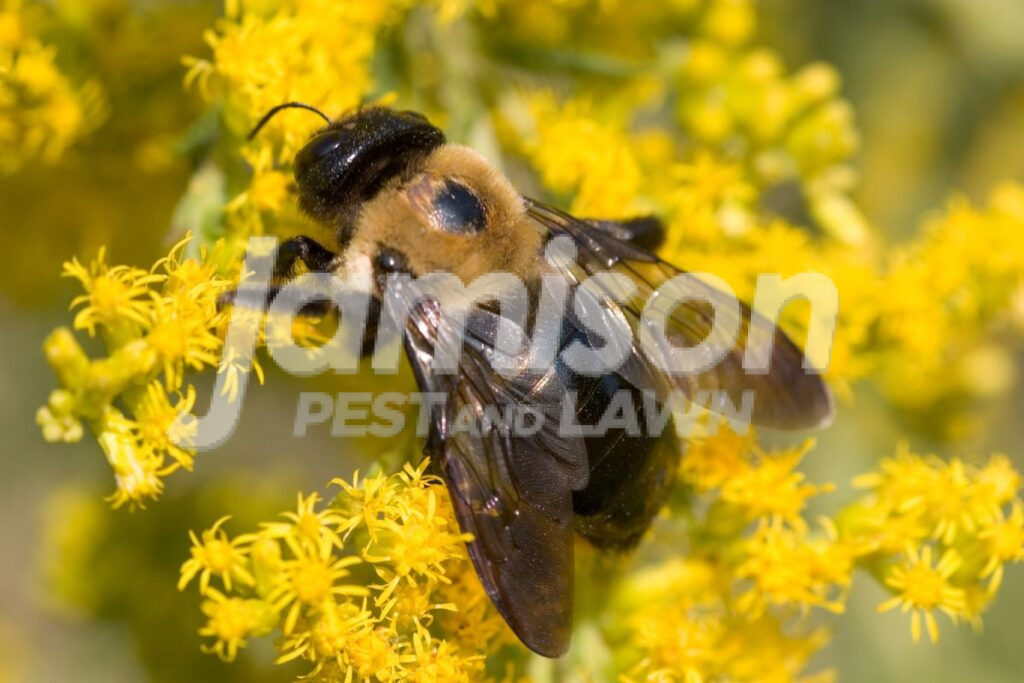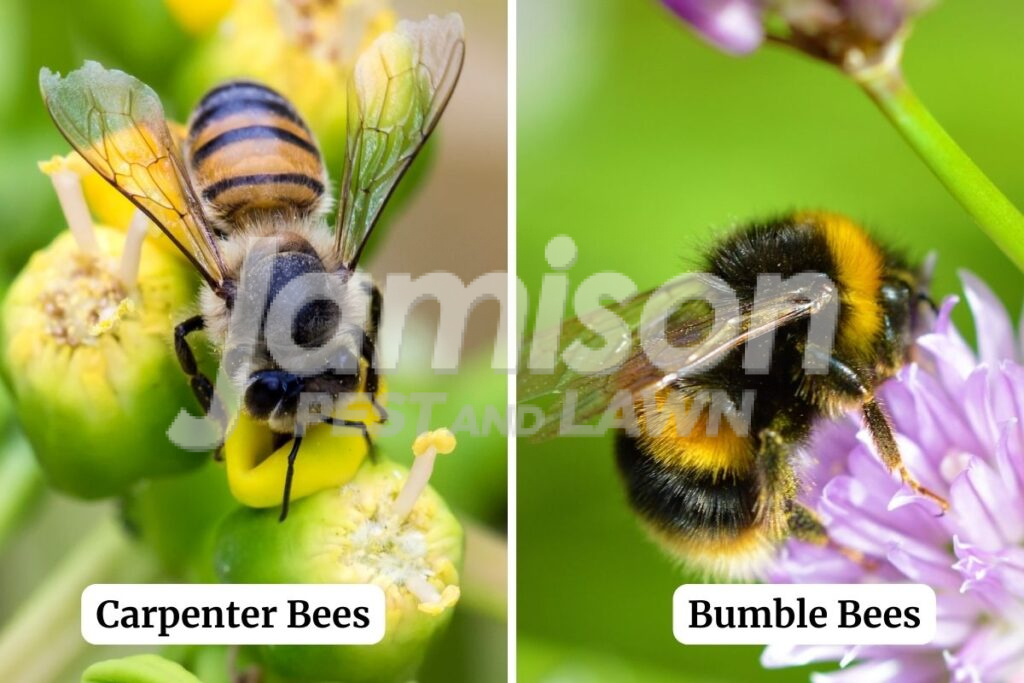The beautiful spring season is here again! The winter is finally over, and it’s time for blooming flowers and pleasant weather, which means the time for hosting outdoor events with all your friends is back. However, before you do this, you should know that along with many positive things, spring is also known for the arrival of bugs.
In our previous blog posts, we have covered several pests such as termites and roof rats, but today, we’ll discuss carpenter bees.
As a homeowner who loves nature, you may be wondering, are carpenter bees dangerous? What can they do? How can you stay safe? Today we’ll answer all of it so you can feel well-informed about tackling these pests.
What Is A Carpenter Bee?
Carpenter bees are large insects that get their name from their amazing woodworking ability. They have an all-black body with some yellow markings and a smooth, shiny abdomen.
These bees don’t live in hives like honey bees. Instead, the adult female carpenter bee uses her strong jaws, which are like tiny drill bits, to create a neat entrance hole in a wooden structure. Once inside, she hollows the structure out more with little tunnels where she lays her eggs and stores food for her babies.
Carpenter bees are much larger than regular honey bees. The entrance holes they make are around 1/2 inch across, which is just big enough for the bee to fit through. As the carpenter bee digs deeper into the wood, she pushes out a trail of sawdust-like material called frass.
While they’re not a threat to humans, they are a nuisance due to the damage they can cause to the siding of your home, decks, fence posts, and more. This nesting behavior is what makes carpenter bees so interesting, but it’s also potentially problematic for homeowners.

Signs of Carpenter Bee Infestation
Homeowners in Memphis should be vigilant for the following signs of carpenter bee activity:
- Perfectly round holes in wooden surfaces, about 1/2 inch in diameter
- Piles of sawdust-like frass that has accumulated below the holes
- Loud buzzing noises coming from inside the wood, indicating bee activity
Carpenter Bees vs. Bumble Bees: What Are The Differences?

Carpenter bees belong to the genus Xylocopa and are often mistaken for bumble bees due to their similar appearance. Like bumble bees, they are pollinators too. However, unlike their fuzzy counterparts, carpenter bees have shiny, black abdomens.
- Body Appearance: Bumble bees have a fuzzy, hairy body which helps them collect pollen. In contrast, carpenter bees have a smooth, shiny black abdomen with little to no hair.
- Nesting Habits: Bumble bees nest in the ground or in pre-existing cavities, while carpenter bees bore perfectly round holes into wood to create their nests. This wood-boring behavior is where carpenter bees get their name.
- Sociality: Bumble bees are social insects that live in colonies with a queen, workers, and males. Carpenter bees are solitary, with each female creating her own individual nest.
Are Carpenter Bees Dangerous To Humans?
When it comes to bees, most of us have the same couple questions: Can they bite? Do carpenter bees sting?
While carpenter bees may look intimidating with their large size and loud buzzing, the truth is that they are generally not dangerous to humans. However, there are a few important points to keep in mind:
For example, only female carpenter bees can sting, and they tend to be docile unless their nests are directly threatened or disturbed. Male carpenter bees lack a stinger entirely.
However, carpenter bee venom is relatively mild and does not typically cause severe allergic reactions like those associated with honey bees or wasp stings, so you’re relatively safe.
Are Carpenter Bees Dangerous To Wood/Furniture?
The major reason why homeowners aim to get rid of carpenter bees is due to the damage they can wreak on your home and lawn.
As we have seen above, these bees may not pose a significant threat to us. But what about our furniture?
.They dig holes in wood and stay there. This is where their real danger lies, and you should take the necessary preventative measures to protect your home.
As we know, carpenter bees rely on wood for shelter but unlike wood termites, they’d don’t digest the wood, just drill into it with their jaws, causing damage.
The holes they leave in wood and furniture are typically about 1/2 inch in diameter and will even lay their eggs in these holes, which can add to the problem.
Over time, as multiple carpenter bees create nests within the same wooden structure, the effect can weaken the integrity of the wood, potentially leading to expensive repairs or replacements. This is especially concerning in load-bearing structures, where compromised wood can pose a safety hazard.
Additionally, the presence of carpenter bee holes and tunnels can provide entry points for other small pests, such as ants, termites, or wood-boring beetles, further aggravating the damage.
How To Control Carpenter Bee Infestation
To get rid of carpenter bees effectively, you need to combine both prevention and control methods.
Preventing Carpenter Bee Infestations
Here are some proactive measures you can take to prevent carpenter bees from going near your home and other wooden structures:
- Seal entry points: Caulk or seal any cracks, crevices, or gaps in your home’s exterior to eliminate potential nesting sites.
- Apply wood sealants: Treat exposed wood surfaces with polyurethane, paint, or other protective coatings to deter carpenter bees from burrowing.
- Replace damaged wood: If you notice any severely compromised wooden components, replace them promptly to remove existing nests and prevent further infestation.
Controlling Carpenter Bee Populations
If you’ve already spotted carpenter bees around your property, it’s time to take action. Here are some effective control methods:
- Insecticidal Dust: Carefully puff insecticidal dust into the entry holes to eliminate nests inside the wood.
- Liquid Insecticides: Apply liquid insecticides directly into the holes or spray them onto infested surfaces.
- Set Up Traps: Set up carpenter bee traps around your property to capture and remove adult bees.
- Hire A Pest Control Expert: For severe infestations or hard-to-reach areas, seek the expertise of a professional pest control company in Memphis.
Jamison Pest And Lawn: Your Solution To Getting Rid Of Carpenter Bees!
Tired of keeping bees out of your home or your yard? If so, then it’s time to move ahead and hire our experienced team at Jamison Pest and Lawn. We are a leading pest control company serving Memphis.
Our flagship one-time treatment program will help you get rid of carpenter bees for good. We employ the latest, most effective techniques to make sure your home stays safe from pesky creatures. Contact us today (901) 452-1505 to find out more.




